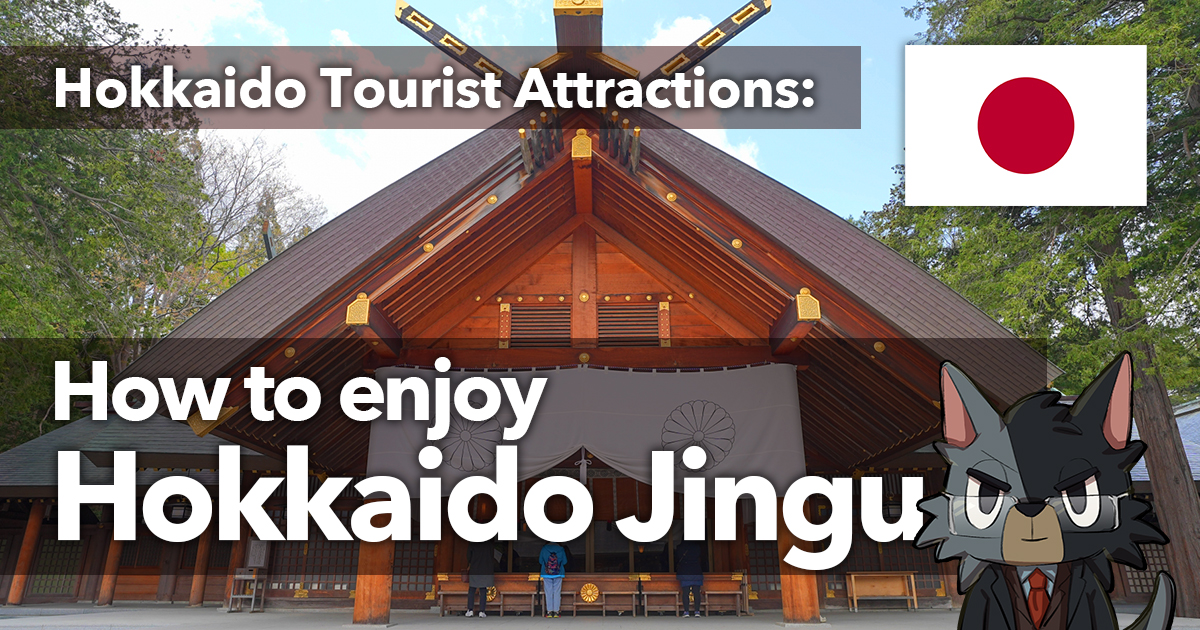INTRODUCTION
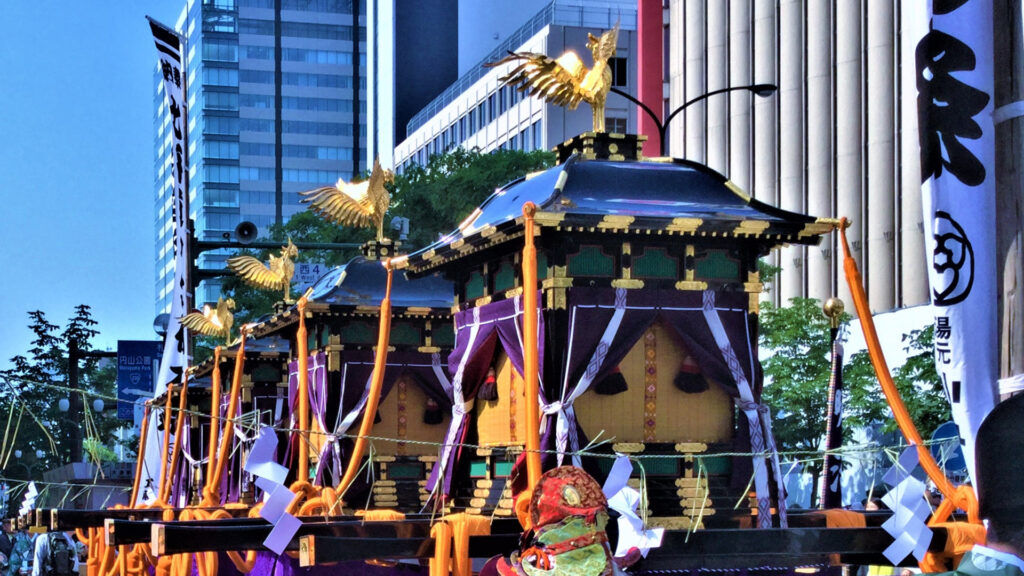
Hokkaido Jingu is a historically and culturally significant shrine located in Sapporo, Hokkaido, and is a tourist attraction where visitors can experience the traditions and beauty of Japan.Founded in 1871, the shrine is dedicated to Okuninushi no Okami, the pioneer god of Hokkaido, and other deities, and attracts many visitors and worshippers The shrine is located on a large site.
Surrounded by vast grounds and beautiful natural surroundings, Hokkaido Jingu Shrine offers a variety of seasonal scenery. In spring, cherry blossoms are in full bloom, summer brings fresh greenery, autumn brings beautiful colors of autumn leaves, and winter brings snowy landscapes. In particular, the cherry blossom festival in spring and the snowy landscape in winter are highlights not to be missed.
Inside the shrine, traditional buildings such as the main hall, worship hall, and kaguraden (Shinto music and dance hall) offer visitors a taste of Japanese culture and history. As you walk along the approach to the shrine, you will be surrounded by a solemn atmosphere and at the same time enjoy the beauty of nature. There are also many seasonal festivals and events, so you can enjoy different attractions depending on the time of year you visit.
In this article, we will introduce in detail the history of the Hokkaido Jingu Shrine, its highlights, how to get there, and useful information on nearby dining and shopping spots for your visit. We hope you will visit the Hokkaido Jingu Shrine and experience its charms to the fullest during your trip to Hokkaido.
History and Culture of Tourist Attractions
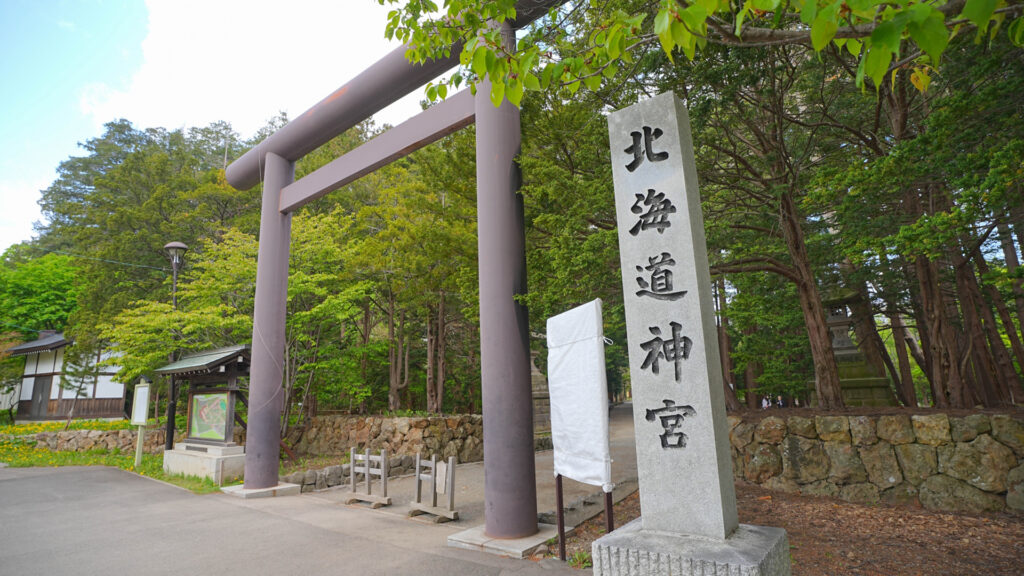
Hokkaido Jingu is an important shrine located in Sapporo, Hokkaido, and has a very rich history and cultural background. This shrine was founded in 1871 and established by pioneers of Hokkaido. Initially known as “Sapporo Shrine,” it was renamed “Hokkaido Jingu” in 1964.
Historical Background
Hokkaido Jingu enshrines the deities that supported the pioneering and development of Hokkaido. The main deities are Okuninushi no Okami (Great God of the Land) and the three Kaitakushi deities (Ohonamujimikoto, Sunahikonomikoto, and Karakoromuchi no Okami). These deities are believed to aid in the development of agriculture, medicine, and commerce, and to protect the abundant nature of Hokkaido and the lives of its people.
At the time of the shrine’s construction, Hokkaido was still an undeveloped region, and many pioneers were forced to live in harsh conditions. Under such circumstances, the Hokkaido Jingu Shrine became a spiritual center for the pioneers and played an important role in the development of the region.
Cultural Characteristics
Hokkaido Jingu is known for its beautiful architecture and natural environment. The grounds of the shrine are vast, covering an area of approximately 180,000 square meters. Within the grounds are important buildings such as the main shrine, the hall of worship, and the Kaguraden, all of which are constructed in the traditional Japanese architectural style. This allows visitors to experience Japanese culture and history.
Especially in spring, the cherry blossoms on the grounds are in full bloom, attracting many cherry blossom-viewing visitors. The Cherry Blossom Festival at the Hokkaido Shrine is known as a major community event, where locals and tourists alike enjoy the beautiful blossoms. In autumn, the grounds are decorated with autumn leaves, and the seasonal scenery attracts visitors.
Various festivals and events are held throughout the year at Jingu. Visitors can enjoy different seasonal events such as Hatsumode in the New Year, the Cherry Blossom Festival in the spring, the Regular Festival in the summer, the Autumn Leaves Festival in the fall, and the Snow Festival in the winter. These festivals and events are great opportunities to experience local traditions and culture.
Places to visit
Hokkaido Jingu Shrine is a popular tourist destination that combines beautiful nature and historical architecture. Here are some of the main attractions that you should definitely see when visiting.
Main Shrine
The main shrine, the focal point of the Hokkaido Jingu Shrine, is a place where visitors can appreciate the beauty of traditional Japanese shrine architecture. Visitors can experience Japanese Shinto culture through worship in a solemn atmosphere. Many visitors come to pray in front of the main hall.
Worship Hall
The hall of worship is a place where worshippers offer prayers to the gods. Here, visitors can draw omikuji (written oracle) and dedicate ema (votive picture tablet). The hall is especially crowded with worshippers during events such as Hatsumode and Shichi-Go-San.
Kaguraden
Various kagura dances are performed throughout the year in the Kaguraden. Especially during the annual festival, beautifully dressed miko (shrine maidens) perform kagura dances, which attract many visitors to the hall. The dances performed in the Kaguraden are a very important part of Shinto rituals and festivals.
Nature on the grounds
The grounds of the Hokkaido Jingu Shrine are a vast expanse of nature that can be enjoyed in all four seasons. In spring, the cherry blossoms are in full bloom, attracting many cherry blossom-viewing visitors. Especially famous is the “Cherry Blossom Festival at Hokkaido Jingu Shrine,” where visitors can enjoy picnicking and taking pictures under the cherry blossoms in full bloom. In summer, the grounds are covered with beautiful fresh greenery, and in autumn, the autumn leaves brightly illuminate the grounds. In winter, visitors can enjoy the snowy landscape and the solemn atmosphere of the shrine.
Kaitakushi Shrine
There is also a small shrine called “Kaitakushi Shrine” within the precincts of the temple, which enshrines the people who devoted themselves to the development of Hokkaido. Here, visitors can feel the history and efforts of the pioneers, and it is especially recommended for history buffs.
Festivals and Events
Various festivals and events are held throughout the year at the Hokkaido Shrine. The New Year’s Hatsumode (New Year’s visit) attracts a large number of worshippers and is a busy time of the year. Visitors can enjoy different seasonal attractions such as the Cherry Blossom Festival in spring, the Annual Festival in summer, the Autumn Leaves Festival in fall, and the Snow Festival in winter. These festivals are a great opportunity to experience the traditional culture of the region.
Special Experiences
Omikuji and Ema
One of the most fun things to do at shrines is to draw an omikuji, a written oracle that predicts one’s fortune. Omikuji, which divines one’s fortune, is a unique shrine experience that is popular with many visitors. Visitors can also write their wishes on an ema (votive tablet) and dedicate it to the god. Ema hangings have been set up on the shrine grounds and are decorated with the wishes of many people.
Red Seal
A red seal is a popular souvenir of a visit to a shrine. You can also receive a red seal at the Hokkaido Jingu Shrine, and a red seal written in a beautiful font is a wonderful memento to remember your trip.
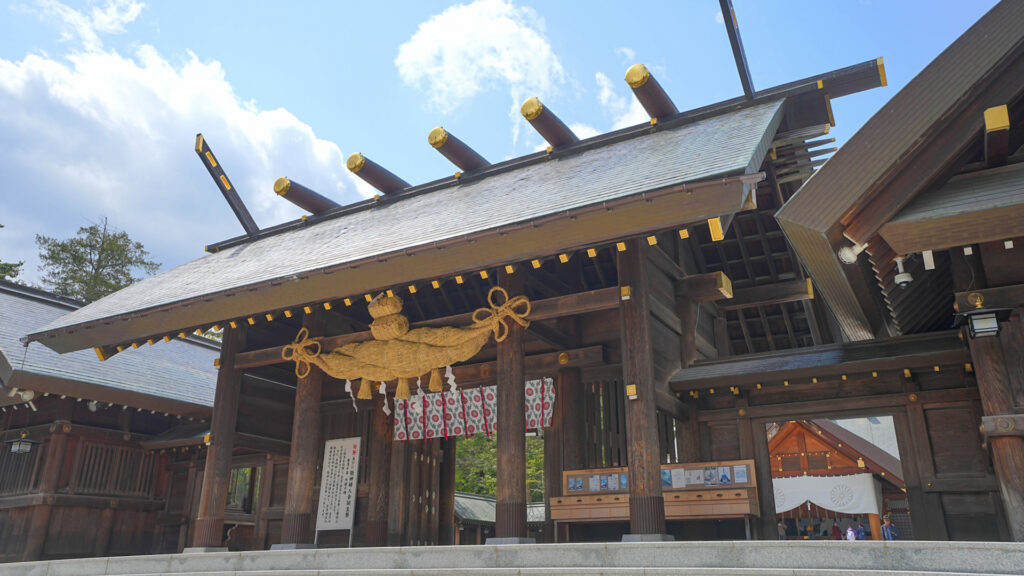
Access
Access to the Hokkaido Jingu Shrine is very convenient, and various means of transportation are available from Sapporo City. The following is an overview of how to access the shrine by various means of transportation.
Access from Sapporo Station
By Subway
Tozai Line: Take the Tozai Line from Sapporo Station to Maruyama Koen Station. It takes about 10 minutes.
On foot: It takes about 15 minutes from Maruyama Koen Station to Hokkaido Shrine on foot. The most common route is to exit Maruyama Koen Station and walk through Maruyama Park.
By bus
JR Hokkaido Bus: Take the bus bound for Maruyama Bus Terminal from Sapporo Station Bus Terminal and get off at the last stop. The trip takes about 25 minutes.
On foot: It takes about 10 minutes from Maruyama Bus Terminal to Hokkaido Jingu Shrine on foot.
Access from New Chitose Airport
By train
JR Kaisoku Airport: Take the JR Kaisoku Airport from New Chitose Airport to Sapporo Station in about 40 minutes.
Subway Tozai Line: From Sapporo Station, transfer to the Subway Tozai Line and get off at Maruyama Koen Station. The trip takes about 10 minutes.
Walking: It takes about 15 minutes from Maruyama Koen Station to Hokkaido Shrine on foot.
By bus
Airport shuttle bus: Take the airport shuttle bus from New Chitose Airport to Sapporo City and get off at Sapporo Station Bus Terminal. It takes about 1 hour and 10 minutes.
JR Hokkaido Bus: Take the bus bound for Maruyama Bus Terminal from Sapporo Station Bus Terminal and get off at the last stop. The trip takes about 25 minutes.
Walking: It takes about 10 minutes from Maruyama Bus Terminal to Hokkaido Jingu Shrine on foot.
Access by Car・Parking
The Hokkaido Jingu Shrine has its own parking lot. There are several free parking lots available, and you can park close to the grounds.
However, it is recommended to use public transportation, especially during Hatsumode and festivals, as the area becomes very crowded.
Hours of Operation and Admission Fees
Hokkaido Jingu welcomes visitors and tourists throughout the year, and there are no specific hours of operation or admission fees. However, the facilities within the shrine and the awarding office (where omamori and o-fuda are sold) do have set hours of operation, which are detailed below.
Business Hours
Opening Hours: Always open (24 hours)
The precincts of the Hokkaido Jingu Shrine are open 24 hours a day, allowing visitors to freely worship and explore the shrine at any time. Early morning and evening are especially recommended times to visit the shrine, as they offer a quiet and serene atmosphere.
Awarding Office (sales of amulets and charms)
Hours of operation
Summer (April – October): 7:00 a.m. – 5:00 p.m.
Winter (November – March): 7:30 a.m. – 4:00 p.m.
At the gift shop, you can purchase good luck charms, omifuda (talismans), omikuji (omikuji fortune), etc. The hours vary depending on the season. Since the hours of operation vary depending on the season, it is advisable to check the hours before visiting.
Prayer reception desk
Hours of operation
Summer (April to October): 8:30 a.m. to 4:00 p.m.
Winter (November to March): 8:30 a.m. to 3:30 p.m.
Prayer requests must be made in advance at the reception desk. For details and fees for prayer services, please visit the shrine’s official website or visit the site.
Hokkaido Jingu Tongu
Address: Minami 2-jo Higashi 3-chome, Chuo-ku, Sapporo
Another branch of the Hokkaido Jingu Shrine, the Hokkaido Jingu Tongu, is also worth a visit. Located in the city center, the precincts of the shrine are open to visitors at any time, but the awarding office and prayer desk are open during certain hours.
Admission Fees
Admission to the grounds of Hokkaido Jingu is free. Anyone is free to visit the shrine and stroll around. Special festivals and events are also usually free of charge, although fees may apply for some special worships and events.
Special festivals and events
Throughout the year, various festivals and events are held at the Hokkaido Jingu Shrine. Typical events include the following
Hatsumode (New Year’s Pilgrimage): Hatsumode (New Year’s Pilgrimage) attracts many worshippers and attracts a large crowd. Omikuji (fortune telling) and good luck charms are available for purchase on the temple grounds.
Cherry Blossom Festival: In spring, the cherry trees on the temple grounds are in full bloom, attracting many cherry blossom-viewing visitors. Visitors can relax under the beautiful cherry blossoms.
Reidaesai: In June, the Hokkaido Jingu holds its largest festival, the Reidaesai, which features a parade of portable shrines and traditional dances.
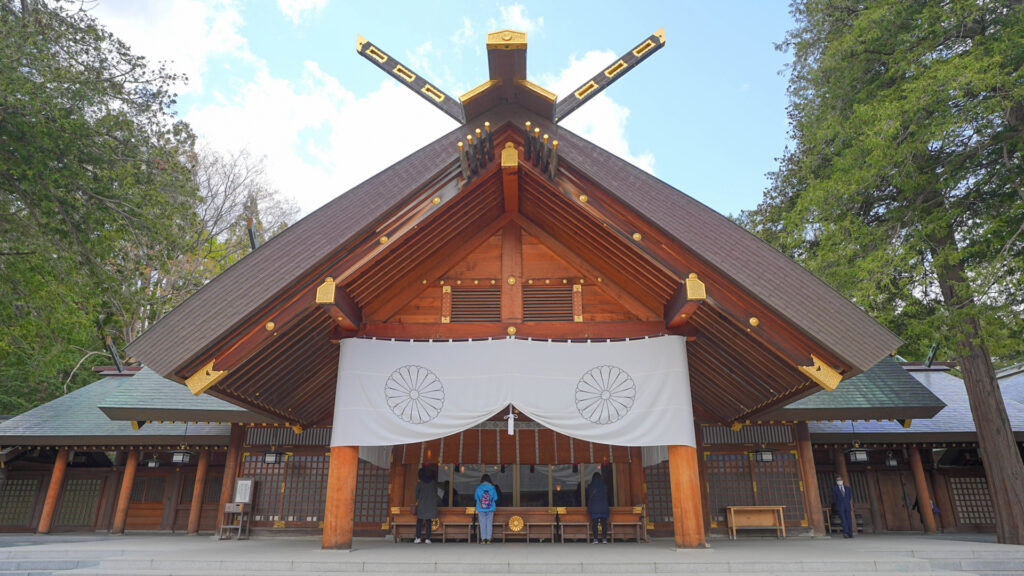
Gourmet
When you visit the Hokkaido Shrine, be sure to enjoy the delicious gourmet spots in the area. There are many restaurants and cafes in the vicinity of the shrine where you can taste dishes made with fresh ingredients unique to Hokkaido and local specialties. Here are some of our recommended gourmet spots.
Recommended Gourmet Spots in Maruyama Area
Moerenuma Park Cafe
Address: 1-1 Moerenuma Park, Higashi-ku, Sapporo, Hokkaido
Recommended menu: Moerenuma Cafe au Lait, homemade cakes
Located in Moerenuma Park, the café offers a relaxing atmosphere with a view of the expansive park scenery. Particularly recommended menu items are café au lait made with Hokkaido milk and homemade cakes.
Michelin Guide Restaurant: Soup Curry Garak
Address: Minami 3-jo Nishi 2-chome, Chuo-ku, Sapporo, Hokkaido
Recommended Menu: Chicken Soup Curry, Vegetable Soup Curry
Soup curry is one of Sapporo’s specialties. Garak, listed in the Michelin Guide, is known for its rich soup and fresh vegetables. The chicken soup curry is especially popular, offering a perfect balance of tender chicken and spicy broth.
Aburiya
Address: Minami 2-jo Nishi 4-chome, Chuo-ku, Sapporo, Hokkaido
Recommended Menu: Kaisendon, Sushi, Genghis Khan
Aburiya is popular among locals and tourists alike for its fresh seafood dishes unique to Hokkaido. In particular, the kaisendon (seafood rice bowl) and sushi are loaded with fresh ingredients, allowing you to enjoy the tastes of Hokkaido. The restaurant also offers Hokkaido’s specialty, Genghis Khan, where you can enjoy the unique flavor of mutton.
Maruyama Pankey
Address: 3-3-3, Miyanomori 3-jo 10-chome, Chuo-ku, Sapporo, Hokkaido
Recommended Menu: Pancake Set, Cafe Latte
Maruyama Pancake is located near Maruyama Park and is popular for its fluffy pancakes. The pancakes, made with carefully selected ingredients, are characterized by their moist texture and gentle sweetness, and are excellent when enjoyed with a café latte.
Morihiko
Address: 26-2-18 Minami 2-jo Nishi, Chuo-ku, Sapporo, Hokkaido
Recommended Menu: Specialty coffee, homemade sweets
Morihiko, located a short walk from Maruyama Park, is one of Sapporo’s representative cafes. You can enjoy carefully brewed specialty coffees in a relaxing atmosphere in a historic building. The homemade sweets are also highly recommended.
Shopping
Hokkaido Shrine Awarding Ceremony Hall
Address: 474 Miyagaoka, Chuo-ku, Sapporo, Hokkaido
At the awarding office of Hokkaido Jingu Shrine, you can purchase souvenirs unique to the shrine, such as amulets, ema (votive picture tablet), and omafuda (talismans). They make great souvenirs to commemorate your visit to the shrine or as gifts for family and friends.
Recommended items
Amulets: Various types of amulets are available, including those for health and traffic safety.
Ema (votive tablet): Visitors can write their wishes on an ema and dedicate it to the shrine.
Summary
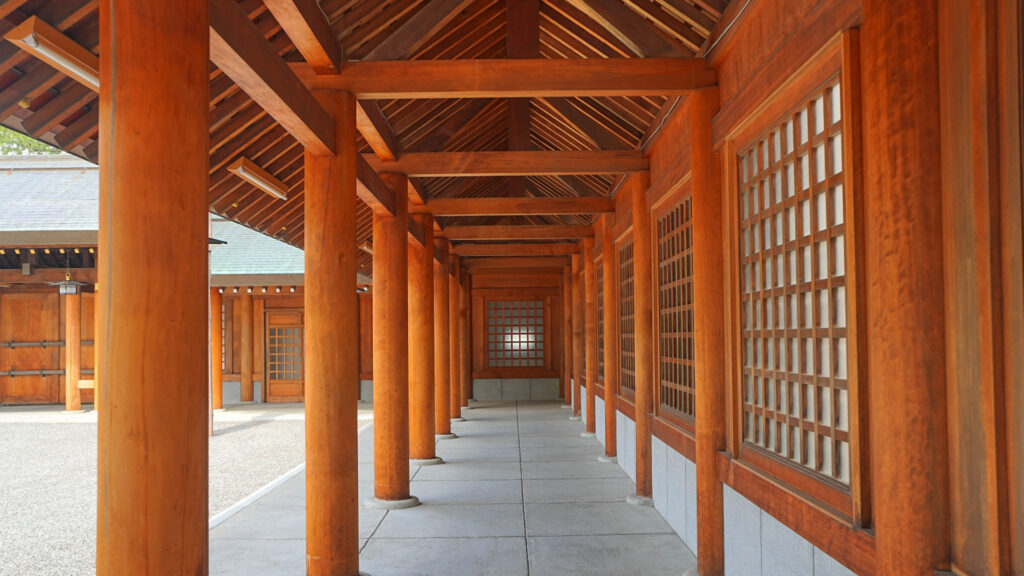
Hokkaido Jingu Shrine is a historical and cultural tourist attraction located in Sapporo, Hokkaido, and attracts visitors with its beautiful nature and traditional architecture. The spacious shrine grounds include the main hall, worship hall, and kaguraden (Shinto music and dance hall), and the scenery changes from season to season. The cherry blossom festival in spring and the snowy landscape in winter are especially worth visiting.
There are many sights to see around the shrine, and each visit offers something new to discover. From the kagura dances at the Kaguraden shrine, to learning about history at the Kaitakushi Shrine, to the festivals and events held throughout the year, you will be able to experience a deep sense of culture and tradition.
Visitors to the Hokkaido Shrine can also enjoy the nearby dining and shopping options. Restaurants and cafes in the Maruyama area offer dishes and sweets made with fresh ingredients unique to Hokkaido. In addition, you can get local specialties and souvenirs at shopping spots in Sapporo. Shiroi Koibito Park and Nijo Market are especially popular among tourists.
Hokkaido Shrine is also conveniently accessible and can be easily visited from Sapporo City by various means of transportation such as subways, buses, and cars. From Sapporo Station, the Tozai Subway Line is convenient, and you can enjoy the path through Maruyama Park to the Jingu Shrine.
We invite you to visit the Hokkaido Jingu Shrine on your trip to Hokkaido and experience its history, culture, and natural beauty to the fullest. You will have a wonderful time through sightseeing, dining, and shopping.

